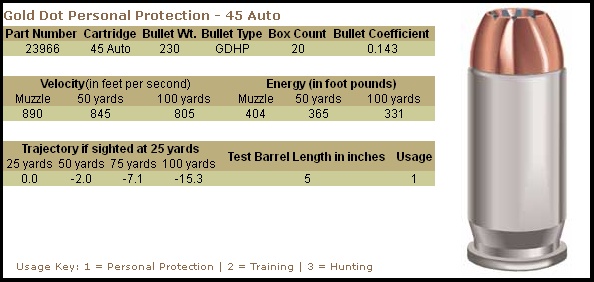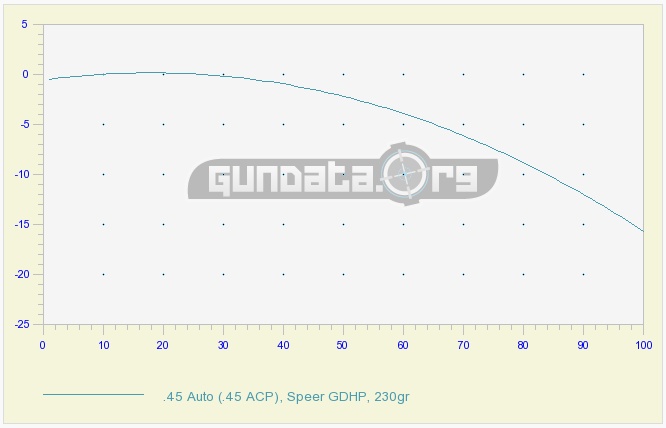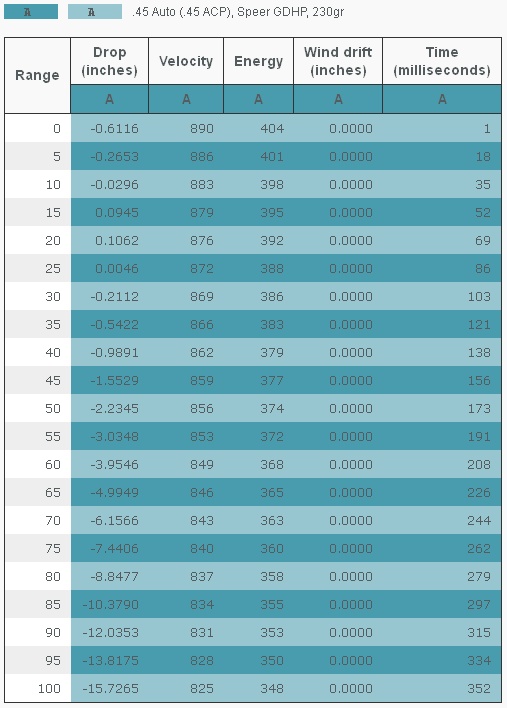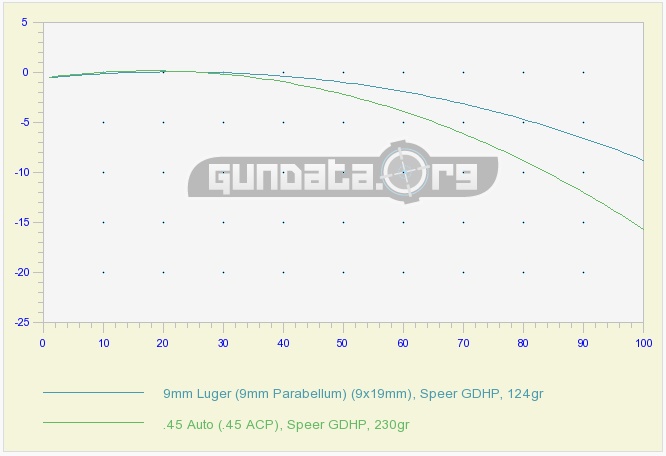If you have been following this series of articles, which was never intended to become a series but, instead, took on a life of its own – welcome to Part 4!
I have taken you on a journey with some ballistic information and how I was applying it to an issue with my Rock Island Armory FS 1911 Tactical; the bullets were not impacting the target at my desired POA at a zero distance of twenty-five yards. Some adjustments were made to the front sight height of the pistol and all seemed to fall into place after putting theory into practice.
Now that I have a good POI=POA at twenty-five yards and inward, what else do I need to concern myself with? How about what that bullet (or bullets) will do once it impacts a target. Whether it is man or beast? To tell the truth of things, I don’t know!
If that fact stops you from reading further, please consider the fact that you don’t know what the bullet of your defense/hunting ammunition will do to man or beast either. So, you might as well keep on reading and allow me to take you to the end of this journey. So far in this series, I have taken you from getting the bullet out of the barrel, evaluating the path that it takes, and making corrections for changing the path that it takes. The final destination is what we call “Terminal Ballistics.”
Terminal ballistics is the study of how a projectile behaves when it hits its target and transfers its kinetic energy to the target. The bullet’s design, as well as its impact velocity (terminal velocity), plays a huge role in how the (terminal) energy is transferred. However, there is more to it than that.
My defensive carry ammunition is (usually) the .45 ACP (Automatic Colt Pistol) Speer BGDHP (Bonded Gold Dot Hollow Point) with a bullet weight of 230-grains.
Since the first part of the terminal ballistic equation is bullet design, let’s take a look at the Speer BGDHP bullet itself. Speer provides the information that follows:
Gold Dot bullets were designed to meet stringent law enforcement standards for dependability and performance. Speer’s Uni-Cor construction bonds the jacket to the core for terrific uniformity, and eliminates the opening found on the base of other bullets giving Gold Dot bullets greater accuracy and the heightened core-jacket integrity also aids in more reliable expansion and greater weight retention. This is not loaded ammunition.
Technical Information
Caliber: 45 ACP
Bullet Diameter: 0.451
Bullet Weight: 230 Grains
Bullet Style: Jacketed Hollow Point
Bullet Coating: Non-coated
Ballistics Information:
Sectional Density: 0.162
Ballistic Coefficient: 0.143
The description tells us that “This is not loaded ammunition.” The next steps would be, obviously, to package it. The hand-loaders among you readers should be reaching for your Speer Reloading Manual; however, and for the rest of us, lets just accept the packaging from the manufacturer, as it would be the most prudent of choice for those of us who carry this ammunition for defensive purposes. Speer, as it would happen, provides the “packaged” information found in the image below.
From the information provided by Speer, we can pull out some specific information regarding velocity, and energy at various points in the bullet’s flight path (trajectory). For example; at the muzzle the Speer GDHP exhibits a velocity of 890 feet-per-second with 404 foot-pounds of energy. At fifty-yards, the bullet is speeding along at 845 feet-per-second and has 365 foot-pounds of energy (out of a test barrel of 5-inches. At 100 yards, the bullet drops 85 feet-per-second in velocity and sheds 73 foot-pounds of energy. But, it doesn’t show us the whole picture. To view a wider picture, we need to go elsewhere.
I have relied on data from GunData.org for providing ballistic data for some time now, and which provides me with general information regarding a “factory-manufactured” cartridge under conditions that I can specify. For example, the graph and table that follows was created by certain factors that I either selected or entered; sight height, zero distance, total distance (the distance that I want to view), and the increments that I want to view (in yards). To keep things simple, I accepted the provided environmental factors (At the distance I will be discussing, environmental factor really have no affect.)
Now, we get a good view of the overall scheme of ballistic things, as shown below.
I get a clearer picture of the round’s capabilities, in regards to ballistics, having this more detailed information available to me. For example, I can see from the chart that the bullet’s velocity drops to eighteen feet per second at twenty-five yards and sixteen foot-pounds of energy is lost during the trip. I can also view bullet drop, velocity, and bullet energy at key points such as fifty-yards, seventy-five yards, and one-hundred yards. It is nice to know information, with the bullet drop being important and would affect my POA adjustment to hit a target at different distances. If I am shooting at a paper target, velocity and energy has little meaning to me. However if that target was made of flesh, blood, bone and other parts that support life, velocity and energy just might play an important part.
From the same website, GunData.org, the following information is provided to us:
45 ACP (Power / Energy)
The average energy that a 45 acp will push is 403 fpps that is using the average 200 gr bullet traveling just over 930 fps. This is a large, slow moving, projectile. Large and slow means it is less likely to over penetrate it’s (sic) target, so all energy is dumped into whatever it impacts. Dimensions – Height: 0.898″ and Width: 0.48″ Gundata.org gives the 45acp a power rank of 3.88 out of 7.
There is one glaring ambiguity in the above statement; “…Large and slow means it is less likely to over penetrate it’s (sic) target, so all energy is dumped into whatever it impacts.” What the statement is saying is that anything that the bullet impacts stops the bullet’s travel. That is not an entirely true statement because the composition of the target matters, as does the distance at which the bullet is fired respective to the target, and the energy that the bullet has when it impacts a target. As important, is what the bullet does when entering the target and, possibly more important, is what the target does when impacted by the bullet. Many who have gone before us have garnered information and have passed their findings so that we can relish and relinquish findings, facts, and supposition as we so wish. Common arguments evolve among shooters as to which cartridge/caliber is better, even to the point of establishing what cartridge/caliber is “best” at the behest of those who wish to know these things. And, ultimately, questions arise regarding “Stopping Power” and “”Knock-down Power” and “One-Shot Stops” of blog, blog, and blog round.
I love the arguments about caliber, and I have to admit that I have click-baited arguments of that sort in the past – and I probably still will in the future – because it is fun. So, just for laughs and giggles, I offer up a comparison of the Speer 9mm, 124-grain GDHP and the Speer .45 ACP, 230-grain GDHP:
At fifty yards for example, and although the 9mm bullet is traveling faster than the 11.46mm bullet, the energy of the 11.46mm bullet is greater. While you can calculate the amount of energy in foot-pounds by using a mathematical formula, it is far easier to use this data to get a general expectation of the bullet’s performance. Again, velocity and energy are not relevant when shooting at paper targets. Trajectory; however, is useful.
Now, and comparing the two, will someone please tell me what cartridge or caliber is better, or even best? Puleeze! Chuck Hawks has another word for it, “Bullistics!” If nothing else, the comparison is interesting, but it does not address the effectiveness of the bullet on a living, breathing target.
According to the article titled, “Handgun Stopping Power: Sizing Up Your Options” by Richard Mann that was published August 29, 2012 in the online edition of American Rifleman:
What about bullet weight and energy? Energy, kinetic energy, is a product of bullet weight and velocity, but two bullets can have the exact same energy and create substantially different wounds based on how they work, how they expand and their path in tissue. Realistically, it makes no sense to base performance on the potential to do work—kinetic energy—if that work is not done. With regard to bullet weight alone, Finn Aagaard, a much respected gunwriter and very experienced big game hunter once wrote, “Given sufficient penetration, what does any additional bullet weight add to killing power? Nothing, absolutely nothing.”
Impact velocity, bullet expansion and actual penetration would seem to be a better guide to the determination of the effectiveness of a bullet on a live target. However, that statement is not the final say.
Regardless of how fast a bullet impacts the target, how well the bullet expands, or how deep the bullet penetrates, the target is still the key to a bullet’s performance. In a defensive shooting situation, regardless if the attacker is two-legged or four-legged, the target determines the “Terminal Effectiveness” of any projectile being sent into the target at the time it is hit with the projectile. While past studies may provide useful information, the information that I am going to find more useful is if I have to shoot man or beast with my chosen ammunition.
I still have an autopsy photo taken of a man who was shot twenty-seven times with 9mm “duty” ammunition by two officers. Not once were any of those shots a head shot; they were all body shots with some to the extremities. The poor fellow looked like he had measles. The facts came out and the man had a high concentration of PCP in his system. In short, he felt no pain – and if there is no pain, there is no gain.
I was not discouraged by the ammunition used, but the lack of effects of the ammunition on this particular individual was something to be concerned about. There was no immediate indication (to the officer’s) that he had been shot! There was neither immediate incapacitation nor signs that the shots were taking affect. One officer, who was interviewed by IAD, simply stated that (loosely quoted); “The man did not stop so we did not stop shooting!” It has to be noted, before somebody asks why head shots were not taken, that the officer’s were not trained for such, and I can attest to that; they were trained to shoot center-of-mass and they did the best that they could in alignment with their training. The officers also had shown how center-of-mass hits are extremely difficult under stress. Under normal circumstances; however, most of the shots fired by the officers would have probably taken down a person who was not under the influence of PCP – maybe.
There is a plethora of articles, data, and stories available to you and it is not my intent to sway opinions one way or the other. Now that I have taken you from barrel to bullet, the termination characteristics of the bullet should be a fitting termination for this series of articles
What is important, regardless of how fast a bullet impacts the target, how well the bullet expands, or how deep the bullet penetrates, and that the target is still the key to a bullet’s performance, is shot placement. That is why all of this experimentation that I have been going through is necessary, if the Rock Island Armory FS 1911 Tactical is to be carried for defensive use – or any handgun for that matter. If I am to be reliant on a handgun for self-defense, then I must have the highest degree of confidence in it – trust takes time.
Now, I am going to stray off-topic for just a bit.
At the beginning of this article, I asked the question, “…what else do I need to concern myself with? How about what that bullet (or bullets) will do once it impacts a target? At this point, the answer is – I still don’t know.
The only thing that I can hope for is that if I am forced to fire my selected cartridge (the Speer 230-grain BGDHP in 11.46mm) I hope that it does its job in a way that it stops a threat as soon as possible. That first, cold-bore shot is important and the bullet needs to be placed on the target with as much accuracy as possible. If the first hit is not immediately lethal, then subsequent hits will often be less effective in quickly dropping the target, even if they are lethal wounds.
It is sometimes advised to go for a “mobility kill” to prevent or stop a charge of an armed aggressor. Once immobilized, and if necessary, the aggressor could be dispatched with a precise shot to the brain. Against humans, the hips are the target because the hips are the center of movement, therefore easier to hit, and because a bone-breaking hit here would put a man down. The power to smash major bones is also sometimes an important attribute for a bullet load.
A multiple shot incident (one of many) conveyed by Massad Ayoob, illustrates the sometimes ineffective efficiency of handgun rounds:
Multiple Shots
Case One was a famous gunfight decades ago in the Chicago area, in which Cook County deputies armed with S&W Model 59 pistols shot it out with a robber who was firing a .45 automatic. They shot him 33 times with Winchester Power Point “soft-nose” 100-grain 9mm bullets. He was still on his feet trying to reload when one cop blasted him from behind with a 12 gauge rifled slug. He was bent over when hit, and was seen to stagger forward as the 1-ounce slug hit his back, coursed through his upper chest, and exited near the collarbone. He stayed on his feet, though, still trying to bring his gun back into action and kill cops. A second slug smashed through his spine and destroyed his heart, lodging inside his chest beneath the sternum, and at last he went down and out.
That’s pretty scary stuff to think about when you are carrying “only” a handgun for your personal defense. It would make one to forget about handguns and simply carry a 12-gauge. We; however, do carry handguns, and as insufficient as they appear to be, according to many shooting studies, they are still relied upon by the majority of us because the handgun is highly portable. The handgun that we do carry needs to be accurate and the operator must be capable of placing rounds with accuracy. In other words, shot placement is king, followed by penetration and cavitation. Had I left the sights on my Rock Island Armory FS 1911 Tactical as they were with the delivered firearm, I would not have been able to place accurate shots on the target. Ballistic-wise, I can only hope that the destination is worth the journey.
It just might take more than one round to stop a threat, but I will do my best to place my rounds in the target as best that I can with as much accuracy as possible. The rest is up to the bullet and the target.
CLOSING IT DOWN
Well, that’s all I have. I have taken you through my journey from bullet to target. I have to say that the Rock Island Armory FS 1911 Tactical has been the impetus for me to learn more about ballistics and its relationship with the pistol and me. The Rock Island Armory FS 1911 Tactical has finally become “Carry Worthy” and I sincerely hope that I don’t have to find out if the Speer 230-grain GDHP cartridge is the same.
I have included numerous resources for your perusal at your leisure. I hope that you will read them.
And, thus concludes the Working the (Trajectory) Angles saga.
RESOURCES
- GunData.org: http://gundata.org/ballistic-calculator/
- Stopping Power: Myths, Legends, and Realities: http://www.policemag.com/channel/weapons/articles/2013/01/stopping-power-myths-legends-and-realities.aspx
- A Beginner’s Guide to Stopping Power: http://chuckhawks.com/beginners_stopping_power.htm
- Terminal Ballistics: http://www.rathcoombe.net/sci-tech/ballistics/mechanics.html
- Shooting Holes in Wounding Theories: http://www.rathcoombe.net/sci-tech/ballistics/myths.html
- Energy Transfer and Other Bullet Bullistics: http://www.chuckhawks.com/energy_transfer.htm
- Handgun Stopping Power: Sizing Up Your Options: https://www.americanrifleman.org/articles/2012/8/29/handgun-stopping-power-sizing-up-your-options/
- Speer Gold Dot Hollow Points: http://www.tactical-life.com/firearms/speer-gold-dot-hollow-points/
- 5 Gunfighting Myths Debunked By Massad Ayoob: http://www.personaldefenseworld.com/2014/10/5-gunfighting-myths-debunked-massad-ayoob/#armed-and-ready
- GunData.org: http://gundata.org/ballistic-calculator/
- Working the (Trajectory) Angles? – Part 1 (Projectile Dysfunction): https://guntoters.com/blog/2016/08/02/working-the-trajectory-angles/
- Working the (Trajectory) Angles? – Part 2 (More Projectile Dysfunction): https://guntoters.com/blog/2016/08/02/working-the-trajectory-angles-part-2/
- Working the (Trajectory) Angles? – Part 3 (From Projectile Dysfunction to Projectile Desirability): https://guntoters.com/blog/2016/08/07/working-the-trajectory-angles-part-3/
BONUS VIDEO:
![]()







